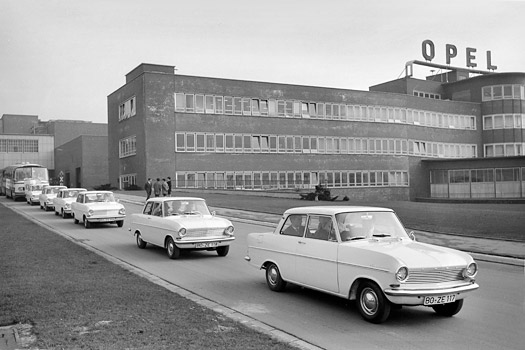
Strukturwandel in Bochum
Vertreter der Landesregierung und der Stadt Bochum verhandelten mit der Adam Opel AG, die einen Produktionsstandort für den neu entwickelten kleinen Mittelklassewagen suchte. Der Coup gelang mit Kapital des US-Mutterkonzerns General Motors und mit erheblicher staatlicher Förderung: Die Adam Opel AG baute auf der ehemaligen Zeche Dannenbaum ihr größtes europäisches Werk.
© Opel Classic Archiv der Adam Opel GmbH, Rüsselsheim
Kapital zurück zur Auswahl
Taking the Kadett to One Stop Shopping
As soon as the news of the location of the Opel factory in Bochum became publicin May 1960 it was a sensation. The “Kadett” was going to help Bochum out of the crisis: coalmines and iron works had shaped the Ruhr area cities for years until the sales of bituminous coal suffered a serious collapse in the second half of the 1950s. Because coal became permanently scarce just a few years prior, crude oil, gas, and imported coal were able to break into the energy market. Now large coal dumps lie full of unsold coal. “Feierschichten” (party shifts) - this is how short-term work was euphemistically referred to - shocked the miners; the first coal mines closed. With the fear of becoming unemployed came the realization that new industries, beyond coal and steel, were missing from the Ruhr area. However, the miners and steel groups feared that skilled employees would be enticed away: using political blocking tactics they would not free up unused areas for new settlements. It is for this reason that representatives of the state government and the city of Bochum secretly negotiated with Adam Opel AG, which was looking for a new production site for a newly developed small mid-range car. The main plant in Rüsselsheim could no longer be expanded. The coup succeeded with capital from the US parent company, General Motors, and with significant government assistance: Adam Opel AG built its largest European factory on the site of the former Dannenbaum coal mine. It brought new jobs and tax revenue to the crisis-torn Bochum; it signaled the upcoming structural transformation of the Ruhr area.
In addition, a “One Stop Shopping center”, modeled after the American consumption model, is located directly along the Ruhr motorway, and can easily be reached with the new (auto-) mobility. The US - American investor Edward J. Roberts set up the Ruhr Park according to the model of the shopping center, which had been developed along arterial city roads in the USA since the 1920s. These were not evolved commercial centers, instead they were planned as single units and operated by Center Management in clusters of leased shops and services. Entirely in keeping with the style of the 1960s, the Ruhr Park was tailor-made for the arrival of the car and was located at the intersection of major thoroughfares for this reason. Generous and free parking spots surrounded the building complex. The construction of the Ruhr Park followed the “bone principle” (“Knochen Prinzip”) tried and tested in America: the complex consisted of two shopping streets for pedestrians (malls) that intersected with each other ; a Quelle department store and a C&A clothing department store were located on two ends. Additional leading companies were a grocery store and a “discount warehouse” (“Kleinpreiswarenhaus”). In between were smaller specialty shops and service companies that profited from the customer traffic generated by the “magnet companies” (“Magnetbetriebe”). Success should soon prove this concept, initially a foreign one in the Ruhr area, successful. By 1969, the Ruhr Park has already been significantly expanded in multiple phases.
Denkmale zum Impuls
Bochum - Opelwerk
Auf dem Gelände der ehemaligen Zeche Dannenbaum in Bochum baute die Adam Opel AG mit ... weiter
Bochum - Shopping-Center Ruhrpark
Als 1964 der Ruhrpark in Bochum-Harpen direkt am Ruhrschnellweg eröffnete, war das eine ... weiter
